To keep goats in a properly confined area, you need an adequate electric fence.
Don’t worry – you cannot harm the animals. You will only warn them to stay away from the fence line.
Want to learn more about the electric fence for goats?
Examine the guidelines below.
Electric fencing for goats: Where to begin?
Let’s start from scratch.
Goats and sheep are similar since both animal types have a robust and inquisitive nature and specific needs.
They wander around, curious and striving to find the greener grass outside the physical barrier.
When building an electric fence, you should consider the following factors:
- type of electric fencing options (permanent, semi-permanent, temporary fences)
- keeping goats and sheep in or predators out of the fences
- main characteristics of the confined animals
What is an ideal fence solution?
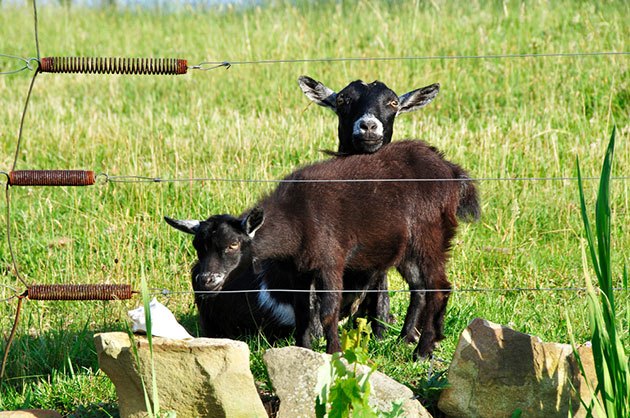
Since goats and sheep are among the most challenging livestock to confine with electric fencing, you need to put much effort into the proper installation.
They test electric fences by jumping over, squeezing between the fence wires, or pushing against the structures.
Another obstacle is finding various types of goats that have specific, thick coats insulating them from electric shocks of the barrier.
Thus, you must have solid, durable, and reliable electric fencing for goats and sheep to prevent their escaping.
As a result, you will also keep predators away from the pasture and fencing.
What equipment do you need?
You need good fence wires and an electric fence charger to build a correct electric fence.
Regarding the fence wire system, the wires should be closely spaced, too low to the ground, and high enough to prevent jumping over.
The best solution is to use 5 or 6 fence wires to the wholesome height between 40 and 46 inches.
The bottom wire should be 8-10 inches off the ground to prevent small animals from escaping.
So, the combination of aluminum or steel wires with high-tensile or T-posts is the best model for that electric fencing.
To pick the best-electrified wires, you can check Amazon and find the most appropriate option for goats and sheep.
You must note that if livestock gets their heads between the fence wires and receive shocks, they will push into the electric fencing instead of pulling out.
So, a proper electric wire spacing – a hot wire at the animal’s shoulder height is crucial to contain your livestock correctly.
In addition, to protect your goats and sheep, you will need a suitable fence charger.
The goat fence requires a specific model, maintaining between 4,000 and 5,000 volts on the electric fence line.
The voltage levels are affected by the type of wires, wire length, and vegetation on the fence line.
Goats and sheep might be attacked by various predators in certain areas, including stray dogs, wolves, coyotes, and similar beasts.
That’s why the goat fence should provide a double performance:
- keeping the goats safe
- chasing the predators away.
However, for these situations, a minimum of 5,000 volts is required.
And the netting fence is about 4 feet tall to prevent the young goats from putting their heads through the netting. So that’s why it’s so tiny in construction.
What about sheep fencing?
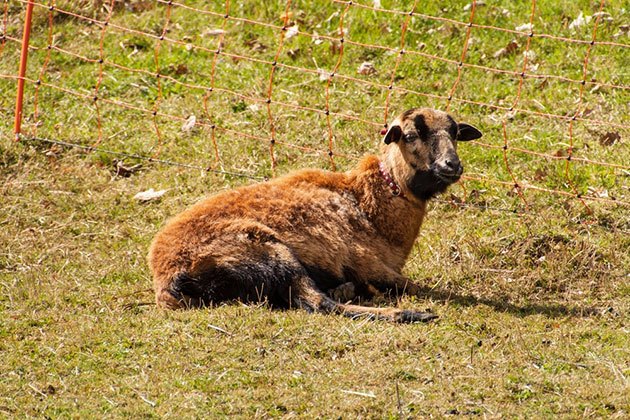
Although they also tend to wander long distances searching for greener grass, they’re more docile and easier to keep inside the physical and psychological barrier.
Yet, as these animals have wool that doesn’t conduct electricity, they present unique challenges.
This is particularly essential when predators are frequent in certain areas.
So, what is the best electric fencing for sheep?
You will need a good fence charger and fence wires to provide extra security.
The number of wires may vary due to the following conditions:
- if predators are a huge issue
- whether you keep lambs and ewes together
- the wire lifespan
Since they’re intense grazers, sheep are famous for grazing outside the boundary fence.
Some effective methods include rotational grazing combined with temporary interior fencing to minimize overgrazing.
You will need 4 to 6 fence wires to enhance your boundary fence.
They should start lower to the ground and spaced to reach between 30 and 42 inches of recommended height of perimeter fencing.
For this purpose, you can use T-posts with an aluminum wire system.
Like goats, sheep require fencing with 4,000 to 5,000 volts of the fence charger power on the fence line.
You must pay attention to the vegetation on the fence lines, wire types, and length.
And in certain areas, sheep can be attacked by various beasts, such as coyotes, stray dogs, wolves, etc.
So, you need at least 5,000 volts for additional security and to prevent carnivores from intruding and harming your cattle.
You can find the best charger here or check different models on Amazon.
Again, if your livestock put their heads between the fence lines and receive shocks, they will push fences instead of pulling their heads out.
Thus, proper wire spacing – hot wires at the animals’ shoulder height is essential for their safety and security.
What are the best fencing types?
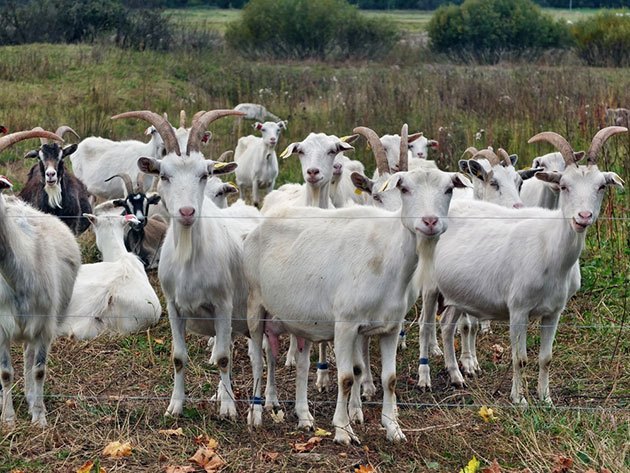
As we have mentioned, there are three types of goat fencing; you can either select temporary, semi-permanent, or permanent fences.
The first one is easy to move around, consisting of electric netting or poly wire reels. It’s ideal for rotational grazing areas or similar situations where you have to move goats quickly.
Semi-permanent goat fences are ideal for a monthly move to a yearly one. In addition, it’s excellent for the thicker fencing posts and taller posts.
Although these fencing models are more robust and reliable than temporary units, they’re not as effective as the permanent structures.
Including 3-5 fence lines lack vertical strands, so there is no correct barrier for goats. They also require more robust corner posts and end posts.
Finally, permanent fencing options don’t require movement. As a result, they’re known as the most reliable and durable options. Although the most pricey, they’re the most quality.
You need stronger wood or steel posts that support high tensile wires, rope, woven wire, or wide tape. But, you can also add electrified high-tensile wire to the existing fencing.
This way, you need insulators to support fence wire strands, holding them 6-8 inches away from your existing fence.
So, based on the needs and behavior of your goats, you can select the right fence for you. The permanent models might require more money, yet their quality is unquestionable.
Still, you have to maintain the fence and keep the fence line clean for better electricity.
Also, in summer, always keep the fence line trimmed and pay attention to the vegetation around it.
How to build a goat fence?
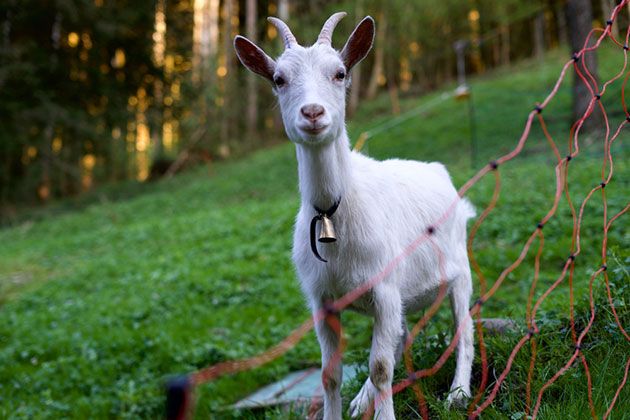
To keep goats contained, you will need various elements:
- fence posts – T-posts with insulators
- high-tensile wire – galvanized steel wire or aluminum wire
- corner posts and insulators
- concrete mix – optional
- charger – solar charger or preferable type
- ground rods
- extra items for the chosen fence type
Remember that the units above are necessary for a chosen fence type, and you may or may not use them for the selected model or existing fence.
Avoid rocky and rough ground for the best effectiveness. Map out the areas where you want to build the hard-wearing fence.
Calculate the exact space the goats need – dairy goats need more space than meat goats, so you may have to alter your confinement space.
Then, once you find the best pasture, you can start building the fence.
Place the grounds in the ground and adequately determine the corners for maximum strength.
Consider utilizing high-tensile, steel, or aluminum wire as your smooth wire types for the best electrical conductivity.
Poly wire is another excellent option for its visibility but is not ideal for shocks as steel wire.
Next, you must level the area and eliminate uneven ground. You also must eliminate vegetation.
Ensure you found the right corners for posts, and use pressure-treated sticks if you don’t use fiberglass or steel rods. The hub and end-post should be bell-shaped.
Assemble the bracing cable starting from the bottom of all ends to the top of the post for the horizontal top member.
As corner braces vary – H, N-brace, or wood post at the top, act accordingly to your needs.
The best solution is the H-brace back to back, 3 vertical posts, 2 horizontal braces, and bracing wire.
Place the posts 3 to 5 feet into the ground for more stability and durability.
Avoid plastic posts as they will not be as strong as other types. Also, you can post posts 60 feet apart and save money.
Next, attach the wiring system. The bottom wire should be 8-10 inches above the ground. You will need 4 to 6 wires, depending on the fence.
The bottom 3 are close and lower to prevent small animals and goats from escaping, keeping beasts out. The other 2 or 3 are taller, with more space for taller livestock.
Congratulations! Your goat fence is fully built and ready for use!
However, remember that the goat fence requires regular maintenance for the best use. So, eliminate weeds and vegetation to prevent accidents.
Also, keep in mind that your goat fencing won’t be adequate without good ground rods. These units work with the charger to provide shocks. If they’re not optimal, your effort is in vain.
To protect goats, electric fencing determines the number of ground rods by the number of joules the charger has.
The 3-feet ground rod is obligatory for every 1 joule.
You should space them 10 feet apart and 10 feet away from the charger and rods. Connect them with the smooth wire and the positive terminal to make it a hot wire.
When using solar power for chargers, ensure they get plenty of sunlight, regardless of their position.
Then, you can test the construction via voltage meters or different testers to prove their optimal performance.
Frequently Asked Questions
How many joules do you need for goats?
You can put ground rods 8 feet into 8 feet of depth about every 400 feet with an 86-joule box. It’s enough to contain goats.
Can an electric fence be used for sheep?
Yes, they can also prevent sheep from escaping and keep them safe. But, again, refer to our guidelines to find the best configurations.
How do you set up an electric fence for sheep?
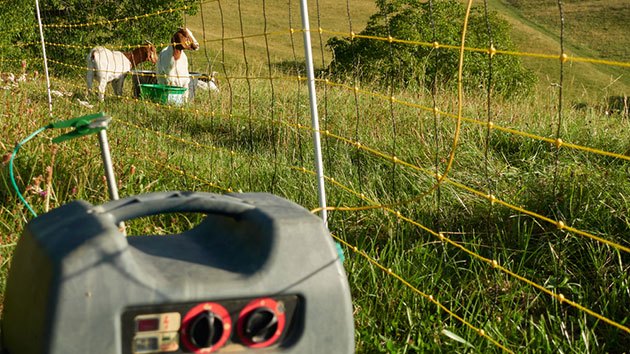
You will need 4-6 wire strands, a charger maintaining 4,000 or 5,000 volts, durable and sturdy post units, and ground rods, and it must be around 4 feet tall.
Refer to our steps above for the complete procedure.
How strong is an electric fence for sheep?
With 4,000 or 5,000 volts on the fence line, these barriers are potent and reliable for keeping them inside predators out.
Still, you should choose more vital wire units, rods, post units, etc.
All that you can find above is in the guidelines.
Summary
Electric fencing provides many benefits for goats and sheep, and you can find them in the article.
So, please, refer to the instruction to avoid complications and prevent accidents when installing your electric fence for goats.
Also, remember crucial factors when considering the best solutions for your needs. Otherwise, you cannot protect the livestock as you should.
